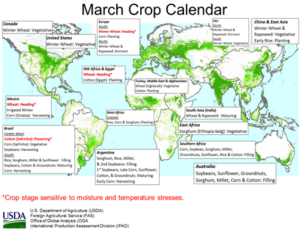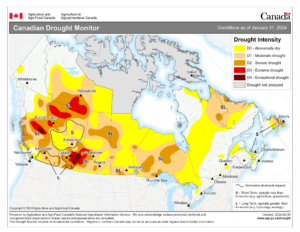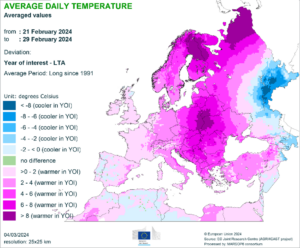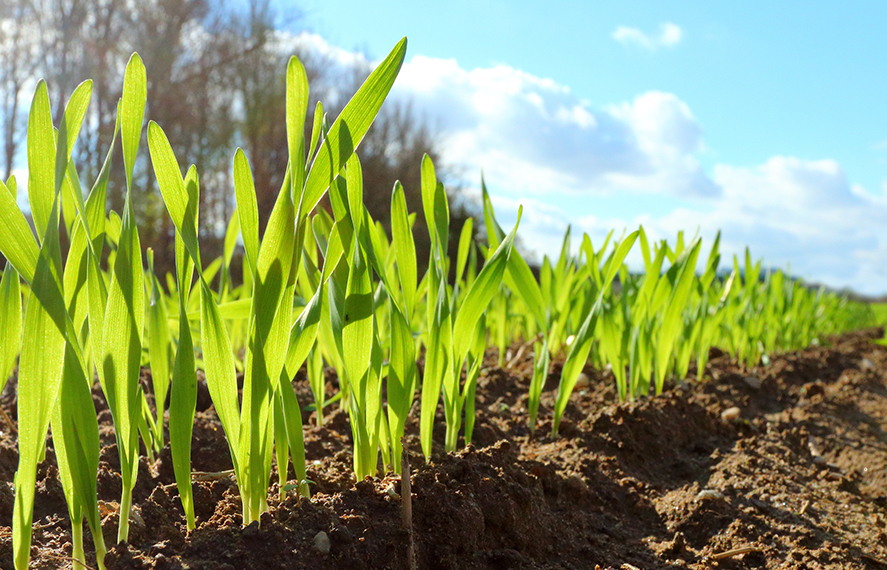As March begins, world wheat markets look to new information that may provide a glimpse into what the 2024/25 marketing year brings. As northern hemisphere winter wheat crops break dormancy, weather becomes increasingly important. Meanwhile, southern hemisphere farmers shift their focus to spring crops and the winter wheat planting season.
While world crop updates will help provide a snapshot of global wheat production and latest conditions over the next few months, U.S. Wheat Associates (USW) is taking this early look at how the 2024/25 world wheat crop is shaping up.

Southern Hemisphere
The southern hemisphere planting program generally begins in April and continues through August, with harvest occurring between October and February, depending on the specific latitude. For marketing year 2023/24, the harvest is complete, with near-final production numbers available for major wheat-producing. Over the last month, Australia and Argentina have benefited from scattered showers and warm weather, boosting yield potential for summer crops, and helping replenish soil moisture for winter wheat planting. Looking ahead, weather analysts predict the potential for a rapid transition from an El Niño weather pattern to a La Niña event between June and August, which will impact weather patterns in the latter half of 2024.

Argentina – The 2023/24 wheat harvest is complete in Argentina, with USDA production estimates at 15.5 MMT, up 3.0 MMT from the previous year. Production is much improved from drought the year prior, though it still sits 12% below the five-year average.
Australia – USDA put Australian wheat production at 25.5 MMT, while the Australian Bureau of Agricultural and Resource Economics (ABARES) estimate was 26.0 MMT for 2023/24. ABARES projected that the 2024/25 harvest may reach upwards of 28.4 MMT due to increased precipitation expected from the transition into a La Niña weather pattern.
Northern Hemisphere
Due to the large geographic area and delineation between winter and spring wheat, northern hemisphere crop calendars vary significantly by region. Winter wheat is generally planted between September and November, while harvest runs from the south to the north from through September. Spring wheat planting typically begins in April and wraps up in June, while harvest can start in July and finish in September. Although the region is geographically diverse, recent weather has been relatively mild across the northern hemisphere; however, winterkill remains a concern in areas with low snow coverage following a cold snap in January.
Canada– The Canadian Grain Commission puts 2024 production at 33.9 MMT. Despite a decrease in acreage from 10.9 million hectares to 10.7 million hectares, the commission expects production to increase on normalized weather and alleviated drought pressure. However, moisture deficits remain in the wheat-producing provinces of Alberta and Saskatchewan. Much of the crop has not yet been planted, but Statistics Canada will release its crop intentions report on March 11.

United States – For harvest in 2024, USDA forecasts total winter and spring wheat planted area at 47.0 million acres (116.1 million hectares), down from 49.6 million acres (122.5 million hectares) in 2023. The USDA Prospective Plantings Report on March 31 will provide additional insight into U.S. wheat plantings. The USDA Grains and Cereals Outlook put U.S. 2024/25 production at 51.7 MMT. Weather remains generally warm in the U.S. Plains, helping winter wheat transition from dormancy.
EU – The EU planted area sits at a four-year low, down 3% to 23.3 million hectares. Wet fall weather inhibited some farmer’s ability to plant in France, Germany, and Poland. Some private analysts have 2024/25 EU production estimates at 142.3 MMT. The weather has been warm and dry in western Europe, contrasting cool and wet weather in the east.
Russia – Private analysts forecast Russian production at 87.7 MMT for 2024/25, while Russian government analysts put output at upwards of 93.0 MMT. Mild weather and above-average precipitation have prevailed across much of Russia, although a cold snap may have slowed crop development in the Volga region.
Ukraine – Similar to Russia, the weather has been warm, accelerating winter wheat transition from dormancy. Estimates are Ukraine has planted approximately 4.2 million hectares for the 2024 harvest, down from 4.4 million hectares last year.

Today’s recap is only a snapshot of the current world wheat situation, which will change as the 2024/25 crop develops and enters different stages of production. As always, weather will ultimately dictate where final production numbers will land. Until then, buyers can look to U.S. Wheat Associates and its state wheat commission members for up-to-date information on crop conditions, weather, and the global supply and demand situation.
By USW Market Analyst Tyllor Ledford


